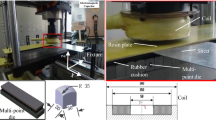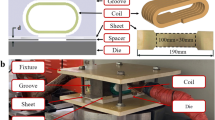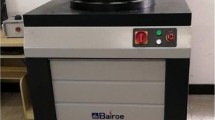Abstract
The electromagnetic forming (EMF) process is an attractive high-speed manufacturing technique that is appropriate for aluminium alloys. This paper outlines experimental work conducted to determine the influence of different process parameters, such as the discharge voltage, lubrication, blank holder force and two-step EMF process, on the dome height, diameter, maximum major/minor strains, strain distribution and thickness distribution of AA 5052 and AA 5754 sheets through the process of electromagnetic free forming. The results show that the dome height and the maximum strain of specimens exhibit linear positive correlations with the discharge voltage. Maximum major strains on the order of 35–45% emerge at the sidewall near the top of the domes, which is also the main area for the thickness reduction, indicating that the inertia effect plays a key role in the EMF process. Increasing lubrication levels or decreasing the blank holder force can augment the deformation height, reduce the major strains and promote material flow. When discharge occurs at the same location, the two-step EMF process does not increase the forming height but can obviously improve the flow of material compared to one-step forming. Furthermore, an appropriate follow-up discharge voltage can thicken the area of the specimen at which necking most easily emerges and reduce the major strains, thereby improving sheet formability.
Similar content being viewed by others
References
Miller WS, Zhuang L, Bottema J, Wittebrood AJ, Smet PD, Haszler A, Vieregge A (2000) Recent development in aluminium alloys for the automotive industry. Mater Sci Eng A 280(1):37–49. https://doi.org/10.1016/S0921-5093(99)00653-X
Heinz A, Haszler A, Keidel C, Moldenhauer S, Benedictus R, Miller WS (2000) Recent development in aluminium alloys for aerospace applications. Mater Sci Eng A 280(1):102–107. https://doi.org/10.1016/S0921-5093(99)00674-7
Daehn GS, Altynova M, Balanethiram VS, Fenton G, Padmanabhan M, Tamhane A, Winnard E (1995) High-velocity metal forming—an old technology addresses new problems. JOM 47(7):42–45
Li C (2004) High energy rate forming technology. National Defense Industry Press, Beijing (In Chinese)
Yu H, Li C, Jiang H, Zhao Z, Deng J, Li Z, Zhang X (2008) Research on magnetic pulse sizing of aluminum tube. Int J Adv Manuf Technol 38(11–12):1165–1171. https://doi.org/10.1007/s00170-007-1158-x
Fan S, Mo J, Fang J, Xie J (2017) Electromagnetic pulse-assisted incremental drawing forming of aluminum alloy cylindrical part and its control strategy. Int J Adv Manuf Technol 1-10. https://doi.org/10.1007/s00170-017-1245-6
Balanethiram VS, Daehn GS (1994) Hyperplasticity: increased forming limits at high workpiece velocity. Scr Met Mater 30(4):515–520. https://doi.org/10.1016/0956-716X(94)90613-0
Lei X, Tan J, Zhan M, Gao P (2017) Dependence of electromagnetic force on rib geometry in the electromagnetic forming of stiffened panels. Int J Adv Manuf Technol 1–10. https://doi.org/10.1007/s00170-017-0821-0
Psyk V, Risch D, Kinsey BL, Tekkaya AE, Kleiner M (2011) Electromagnetic forming—a review. J Mater Process Technol 211(5):787–829. https://doi.org/10.1016/j.jmatprotec.2010.12.012
Jiang H, Li N, Xu Z, Fan Z, Yu H, Liu L (2015) Microstructure, texture and mechanical properties of 5A02 aluminum alloy tubes under electromagnetic bulging. Mater Des 82:106–113. https://doi.org/10.1016/j.matdes.2015.05.047
Kleiner M, Beerwald C, Homberg W (2005) Analysis of process parameters and forming mechanisms within the electromagnetic forming process. Cirp Annals Manuf Technol 54(1):225–228. https://doi.org/10.1016/S0007-8506(07)60089-4
Sedighi M, Karimi-Nemch H, Khandaei M (2011) Effect of sheet thickness on magnitude and distribution of magnetic force in electromagnetic sheet metal forming process. Appl Mech Mater 110-116:3506–3511. https://doi.org/10.4028/www.scientific.net/AMM.110-116.3506
Oliveira DA, Worswick MJ, Finn M, Newman D (2005) Electromagnetic forming of aluminum alloy sheet: free-form and cavity fill experiments and model. J Mater Process Technol 170(1):350–362. https://doi.org/10.1016/j.jmatprotec.2005.04.118
Luo W, Huang L, Li J, Liu X, Wang Z (2014) A novel multi-layer coil for a large and thick-walled component by electromagnetic forming. J Mater Process Technol 214(11):2811–2819
Cui X, Li J, Mo J, Fang J, Zhou B, Xiao X (2016) Effect of the sheet thickness and current damping exponent on the optimum current frequency in electromagnetic forming. Int J Adv Manuf Technol 85(1):843–851. https://doi.org/10.1007/s00170-015-7983-4
Xu JR, Yu HP, Li CF (2013) Effects of process parameters on electromagnetic forming of AZ31 magnesium alloy sheets at room temperature. Int J Adv Manuf Technol 66(9–12):1591–1602. https://doi.org/10.1007/s00170-012-4442-3
Meng Z, Huang S, Hu J, Huang W, Xia Z (2011) Effects of process parameters on warm and electromagnetic hybrid forming of magnesium alloy sheets. J Mater Process Technol 211(5):863–867. https://doi.org/10.1016/j.jmatprotec.2010.05.008
Cheng J, Nemat-Nasser S (2000) A model for experimentally-observed high-strain-rate dynamic strain aging in titanium. Acta Mater 48(12):3131–3144. https://doi.org/10.1016/S1359-6454(00)00124-5
Li FQ, Mo JH, Li JJ, Huang L, Zhou HY (2013) Formability of Ti-6Al-4V titanium alloy sheet in magnetic pulse bulging. Mater Des 52:337–344. https://doi.org/10.1016/j.matdes.2013.05.064
Lee Y (2001) Formability of aluminum alloy tailor welded blanks. Dissertation, University of Waterloo
Noh HG, Song WJ, Kang BS, Kim J (2015) Two-step electromagnetic forming process using spiral forming coils to deform sheet metal in a middle-block die. Int J Adv Manuf Technol 76(9–12):1691–1703. https://doi.org/10.1007/s00170-014-6392-4
Funding
This work was supported by the National Natural Science Foundation of China (Grant No. 51575206, 51435007 and 51705169), the EU Marie Curie Actions-MatProFuture Project (Grant No. FP7-PEOPLE-2012-IRSES-318968), the Innovation Funds for Aerospace Science and Technology from China Aerospace Science and Technology Corporation (Grant No. CASC150704), the Open Funds from the State Key Laboratory of Advanced Design and Manufacturing for Vehicle Body (Grant No. 31615006), the Fundamental Research Funds for the Central University (Grant No. 2016YXZD055) and the China Postdoctoral Science Foundation (Grant No. 2017M61047).
Author information
Authors and Affiliations
Corresponding author
Rights and permissions
About this article
Cite this article
Ma, H., Huang, L., Li, J. et al. Effects of process parameters on electromagnetic sheet free forming of aluminium alloy. Int J Adv Manuf Technol 96, 359–369 (2018). https://doi.org/10.1007/s00170-018-1589-6
Received:
Accepted:
Published:
Issue Date:
DOI: https://doi.org/10.1007/s00170-018-1589-6




